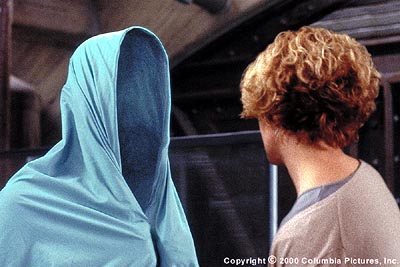I’m pretty sure I saw this a while back when I was obsessed with John Carpenter films, but somehow I never wrote about it. I can see why; while it’s an enjoyable and neatly-plotted film, it doesn’t exactly require complex exegesis. Evil forces of chaos in the person of a (carefully mixed race) LA gang converges on a soon-to-be-decommissioned police station. Good forces of order (with an equally mixed racial profile) resist. Good takes some losses, but ultimately wins. Yay!
Of course, you always know good is going to win in these sorts of films. What’s interesting, maybe, is how little affect goes along with it. It’s possible I’m just jaded, but the sides were drawn so broadly, and the characters were in general so flat, that it was difficult to really feel especially exercised one way or the other about their survival or lack thereof. Ethan Bishop (Austin Stoker) is okay as the inexperienced lieutenant in charge — the actor has some charm, but the writers seem somewhat paralyzed by the film’s audacity in choosing a black man for the role. As a result, the romantic heat gets apportioned out to Napolean Wilson (Darwin Johnston), a dangerous killer turned ally, whose ingratiating bad boy swagger works for about twenty minutes less than the film’s run time. I knew these characters weren’t going to get killed, but if they had I wouldn’t exactly have mourned.
For that matter, the emotional motivator of the film, the senseless shooting of a little girl played by Kim Richards, rather spectacularly fails to emote. Richards, who played Disney roles, trots out every ounce of grating cuteness she can muster, and the actor who plays her dad turns in an Oscar-worthy performance when he merely looks mildly pained rather than actually rolling down the car window and retching noisily. When the kid finally gets shot, my reaction wasn’t stark horror so much as relief that somebody had finally shut her up and I wouldn’t have to hear her whining for ice cream anymore. If civilization demands the defense of this sort of egregious mugging, I think I’m on the side of the faceless Mongol hordes.
If the theme is staid and the plot is predictable and most of the characters are still-born, what’s to like? Well, I like the the way shabby bureaucrat Starker (Charles Cyphers) walks, one shoulder tilted up, so his clothes stick up like he’s wearing a cardboard cutout of a suit rather than the real thing. I like the way one of the gang members looks around the table at his fellows slitting their arms to make a blood pact, turns to his own arm, and slaps it with grim decision to make the vein pop up, as if he’s the world’s most farcically determined Red Cross donor. I liked the ice cream man looking nervously in his mirror at the car driving back and forth, back and forth, and the abrupt irritation with which he turns off his music when he tells that damn girl that the truck is off duty. And I liked just about everything Laurie Zimmer does as the unflappable police secretary Leigh, from the way she barely blinks when she gets shot in the arm to how she languidly sticks a cigarette in Napolean’s mouth to the way she lights the match in a single intense motion. Watching her performance, it’s hard to believe Zimmer never became a star; she’s simultaneously bad ass, vulnerable, and sexy as hell. Sigourney Weaver and Linda Hamilton have nothing on her.
So if the film’s virtues are predicated on its individual moments, does the ideological baggage (good! evil! civilization!) just get in the way? That’s Manny Farber’s termite art point, perhaps — that it’s the small instants of beauty that matter, not the lumbering, gross stabs at significance.
But would those small moments exist without the ideology. It’s the film’s rote latness, the starkness and even clumsiness of the civilization-vs.-chaos schematic, that makes Leigh’s match-strike and all its controlled lust echo with iconic urgency and pleasure. It’s the figuring of the gang as feral beasts which makes that guy striking his arm so hyberbolically sublime. It’s not so much that the moments add up to the ideology as that the ideology makes the moments enjoyable. The meaning is there so you can appreciate the form; the signified points to the sign. If something’s behind you in Plato’s cave, it’s there to add a little shiver between your shoulder blades when Leigh lights that match and the shadows jump out, sexy-cool, against the wall.


